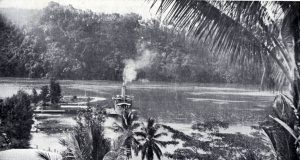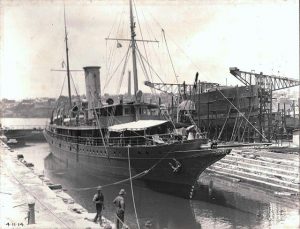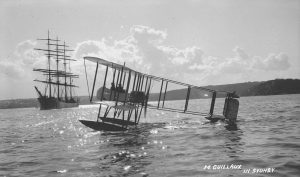- Author
- A.N. Other
- Subjects
- Naval Aviation, Ship histories and stories, History - WW1, History - WW2
- Tags
-
- RAN Ships
- HMAS Una
- Publication
- September 2014 edition of the Naval Historical Review (all rights reserved)
By Leyland Wilkinson
In the latter part of the 19th century, Germany had been actively developing her Pacific island colonies and by 1900 had large holdings to the north of Australia. Berlin saw these as forward bases in a possible conflict with the Australian forces being a likely opposition.
In 1911 KGS Komet (Kaiserliches Governments Schiff – His Majesty’s Government Ship), arrived in Rabaul, on the island of New Britain, which was the administrative centre for the Protectorate of German New Guinea, and headquarters of the Colonial Governor.
Komet had been built on traditional steam yacht lines as a graceful vessel, with a clipper bow and well raked funnel and masts, by Bremer Vulkan at Vegesack, a major shipyard and engineering works. Her keel was laid on 2 August 1910 and she was launched on 4 April 1911. Her length was 64.0 metres with a beam of 9.5 metres, giving 977 gross tonnage. She was powered by two triple expansion engines, delivering an IHP of 1350 for a designed speed of 13 knots. Armament comprised one 37 mm Hotchkiss rapid fire gun mounted on her forecastle, and a single 8 mm machine gun.
With an elaborate radio network being constructed throughout the German possessions, Komet was to be an important link throughout German New Guinea. Instructions from Berlin could thus be rapidly communicated to the Protectorate. Komet had extensions on both masts to raise her radio aerial to a height of 24 metres, thereby improving reception and transmission.
With the declaration of war on 4 August 1914 the Australian Naval Squadron was intent on destroying any enemy ships in its vicinity. A further Imperial objective was for Australian forces to send an expedition to attack the islands of Yap and German New Guinea in order to seize radio-telegraph stations and if possible reuse them for our own purposes. On 5 August HMAS Sydney, in company with the destroyers HMA Ships Yarra and Warrego, left Townsville making for Simpson Harbour (Rabaul); a few days later HMAS Parramatta joined the squadron. They arrived off Rabaul on 11 August only to find the harbour deserted of ships. Komet had departed the day before, making her way to Friedrich Wilhelm Harbour (Madang) to embark the Acting Governor of New Guinea Dr Eduard Haber.
On August 12 Komet received a radio message warning of the whereabouts of the Australian ships; she therefore increased speed to reach the shelter of Matupi, on the southeast coast of New Britain, where Dr Haber, together with a small number of troops, disembarked. After bunkering Komet then slipped through the St. George Channel, between New Britain and New Ireland, evading the Australians.

At noon on 15 August she reached a small uncharted harbour the crew called Komethafen, (Komet Bay) 180 miles from Rabaul. She again bunkered, this time from Siar, a 450 ton steamer of the New Guinea Company, and for the next few days dodged about the coast hiding in quiet anchorages. Meanwhile the Australian ships searched unsuccessfully for the radio station and, running short of fuel, retired to Rossel Islands (to the southeast of Papua) where they rendezvoused with replenishment ships.
Colonel Holmes, the Commander of the Australian Naval and Military Expeditionary Forces, (ANMEF) now headquartered at Rabaul, demanded of Dr Haber that Komet be handed over. He replied that Komet had become a ship of the German East Asiatic Squadron on 1 September and was therefore no longer under his control, and stated that he did not know her whereabouts. Komet was at Peterhaven in the Witu Islands with the crew gainfully employed painting their previously white ship grey. Komet had now become SMS – Seiner Majestät Schiff – His Majesty’s Ship.
SMS Prinz Eitel Friedrich, an armed merchant cruiser, was coaled by Komet at Angaur in the Pelew Islands on 15 September. This ship was an ex-German NDL passenger liner which had been converted to an armed cruiser at the German Naval Base at Tsingtao. As part of Vice Admiral von Spee’s East Asiatic Squadron she became a very successful commerce raider, remaining at large for seven months between August 1914 and March 1915. She sank 11 ships totalling 33,423 tons, including William P Frye which on 27 January 1915 became the first US flagged vessel sunk in WW I.
On 26 September Captain Moller took Komet back to Peterhaven, taking on provisions and water there before returning to Komethafen on 4 October. On the same day just before the departure of the RAN Squadron and the troop transport HMAS Berrima from Rabaul, the radio station at Namanula (near Rabaul) intercepted a mysterious message from an unknown station, containing elaborate details as to the disposition of the Australian ships, and the number of troops in New Britain. It was surmised that this information was transmitted from Komet.
The following day, Colonel Holmes received information from Mr Stephen Whiteman, a local trader, that Komet was concealed at Talasea, about 170 miles from Rabaul, and that he (Whiteman) would be prepared to take an expedition there. Lieutenant Colonel Paton was then ordered to proceed in Nusa, a small 60 ton Government steamer that had been captured by Warrego some weeks earlier, accompanied by Lieutenant Commander Jackson with a party of naval and military personnel. Nusa arrived at Talasea, a small plantation along the north coast, and anchored at dusk on 10 October, close up on a small island. Komet’s location was now confirmed, hidden in a small bay, and well screened from the sea by coconut trees. A plan of attack was then prepared for the next morning.
Lieutenant Colonel Paton reported later:
As we steamed along at half speed in the haze at dawn on the 11th, the masts of the Komet were observed through the trees at a range of 1,500 yards. The Nusa went full speed ahead and rounded the point behind which the Komet was sheltering, and stopped broadside on at a distance of 400 yards. I proceeded in a boat with Mr Whiteman as interpreter, under a white flag. The Captain was not dressed, and shaving, when I reached the Komet, and surrendered the ship in response to my demand. The necessary steps were at once taken for the protection of the wireless room, engine room, and all on board disarmed. The Komet has been captured undamaged, and the wireless plant is aboard and in working order.
Arrangements were then made for both vessels to leave for Rabaul and on 13 October LCDR Jackson, aboard the diminutive Nusa, led his prize into the harbour. Komet remained for four days, coaling and provisioning before sailing to Sydney and arriving alongside at Garden Island on 29 October. This was not the first time Komet had been in Sydney; 12 months prior to her capture she attended the celebrations for the First Fleet entry of the new Australian Navy, as the representative of the colonial administration of German New Guinea. A photograph taken at the time shows Komet dressed overall for the occasion in the company of ships she would meet again under different circumstances.
Komet’s arrival in Sydney and the story of her capture were well reported by the press. On board were ex-Governor Haber and 11 other German prisoners of war who were interned at Holsworthy. A headlined reads: “Australia’s First Capture – A valuable Prize”.
Lying alongside Garden Island is a long grey, cleanly built steamer, with two tall raking masts, and a quick firing gun mounted in the bows. She flies the white ensign at the main, where less than a month ago the big black eagle of Germany flapped his wings in the breeze. Such is the Komet, formerly the German Government Steam Yacht, based at Rabaul, which arrived in Sydney about 8 o’clock yesterday morning.
A visit to the Komet affords sufficient evidence that she is a valuable acquisition. From the fore-deck one enters a luxurious and heavily carpeted music room, a round table of oak, well-nigh large enough to accommodate Arthur and all his Knights, and big leather armchairs admirably suited for the seats of the mighty. For this together with the equally elaborate cabins, bathroom and other offices, composes the Governor’s private suite. Above on the bridge deck a companion suite is set apart for the Captain, and amidships a large and comfortable saloon displays walls panelled in dark woods alternated with dark green tiles and a picture, finely executed, of a schooner in a rough sea. On each side of the ship run a series of comfortably appointed two berth cabins, and there are separate quarters for the crew and for natives. Her engine room is particularly well found, and when one adds a complete wireless outfit, one is not surprised to learn that her cost was in the close neighbourhood of £45,000, or 900,000 marks.
The German officers, who were aboard the Komet when she was captured, are fine types of men, similar to those usually met within the German Merchant Service, and spoke English fairly well. On the arrival of the Komet they were all granted parole, and during the afternoon they visited the offices of the North German Lloyd Shipping Company to arrange accommodation while in Sydney.

On 4 November Komet entered Fitzroy Graving Dock at Cockatoo Island where general maintenance and minor modifications were undertaken. She was also fitted with 3 x 4-inch (102 mm) guns, and 2 x 12 pounder guns, and emerged on 17 November, ready for commissioning as HMAS Una. Then just seven weeks after her capture, she set sail again for New Guinea on 30 November, this time as part of the ANMEF. Amongst her cargo were two aeroplanes, their pilots and mechanics, thus becoming Australia’s first military operational aviation deployment. The emerging technology afforded by these aircraft would, it was believed, prove invaluable in reporting the position of enemy ships.
The first aircraft was a De Havilland BE 2A (British Experimental) two seater biplane, one of two shipped from the Royal Aircraft Factory, Farnborough, which had been used as a training aircraft at the CFS since February 1914. The second was a Maurice Farman MF11 Shorthorn two seat float plane, also referred to as a water plane, hydro-aeroplane, or seaplane, similar to the type then being used by the Royal Naval Air Service, but unique to Australia at that time.

This float plane had been purchased by Mr Lebbeus Hordern a member of the wealthy Sydney retailing family and aviation enthusiast. He had not long taken delivery of the aircraft when war broke out. Mr Horden graciously presented it to the Australian Government and it was taken on strength at Point Cook for war service. Mr Hordern had purchased his plane for £1,600 and it was shipped from France in four crates, to be assembled near his house at Darling Point on the shores of Sydney Harbour. It was 30 ft long (9.3 m), with a 53 ft wingspan (16.2 m), powered by an 8 cylinder 70 HP Renault engine, giving a speed of 60 mph (80.4 km/hr). The services of Maurice Guilleaux, a renowned French aviator who was touring Australia at the time, had been engaged to undertake the assembly and test fly the aircraft.
Thus on 8 May1914, the test flight took place in front of hundreds of spectators, some of whom held the plane until it was ready to take off. The Sydney Morning Herald tells of excited people with their hats blown off as the engine gained power, and the hydro aeroplane skimmed across the water, took off and circled the harbour, returning to splash-land in front of the cheering crowd. This became the first flight of a seaplane in Australia, which was later to become Aircraft No CFS7 at Point Cook. Shortly after the pilot Maurice Guilleaux flew his own Bleriot X1 from Melbourne to Sydney in July 1914, carrying the first air mail in Australia. A postage stamp was struck to mark to occasion, and his plane is now housed in the PowerHouse Museum, Sydney.
The shipment of these aircraft and their associated equipment to Sydney and delivery to Una was completed in only two days. A report of this rapid mobility makes interesting reading:
On 27 November a decision was made to send two pilots and four mechanics to New Guinea by HMAS Una. Lieutenant Harrison who was in Sydney, and just leaving for Melbourne, was ordered to take charge of the party, and Lt. Merz1 to be second pilot, Sergeant Shorland and Privates McIntosh, Mason and Pivot, to be mechanics. At 12 noon instructions were forwarded to the Flying School to dismantle and pack the M F Hydroplane and a BE 2A biplane (the latter could also be reconfigured as a float plane) ready for shipment, the whole to be on the railway trucks at Werribee at 3 am next morning, and then to be attached to the Sydney mail train leaving at 6.15 am 28 November. Some oil and other stores were forwarded by the express leaving Melbourne at 5 pm on the 28th. In addition to the complete machines, a set of duplicate parts for each machine was taken. The Commander of HMAS Una telegraphed at 2.30 pm 29 November that all the machines and personnel had arrived safely.
On this voyage north, Una was also tasked with escorting the newly chartered troop transport Eastern, carrying 249 troops of all ranks, and a vast cargo of frozen meats and other provisions, bound for Rabaul. On her arrival in New Guinea waters, Una found that the campaign against the German forces had proceeded satisfactorily, and the services of her aircraft were no longer required. Surprisingly, given the opportunity to test this new technology they remained on board until eventually returned to Point Cook in February 1915, still uncrated and unscathed.
The story of Una’s continued extensive war service has been well documented and recorded. After decommissioning in 1924 she was acquired by Port Phillip Sea Pilots Association and was renamed Akuna, and then served for the next 30 years as the pilot tender for the Port of Melbourne. During this period Akuna was requisitioned during WW II for use as an examination vessel, operating in the approaches to Port Phillip Bay. After the war Akuna continued to serve the Pilots Association until her replacement in 1953. After 44 years of remarkable service she was sold the next year for scrap, and towed up the Maribyrnong River to Footscray for breaking up.
Many collectable items from the ship remain in museums and private collections. Her ship’s wheel and anchor are both housed in the Old Pilot Station Museum at Queenscliff, Melbourne. The 37 mm Hotchkiss gun mounting, originally fitted to Komet, was removed by Cockatoo Dockyard during the refit/conversion to Una in 1914, and is now on display in the Naval Heritage Centre at Garden Island, Sydney.
Summary
The first vessel captured by the ANMEF was the small German government steamer Nusa and she was instrumental in carrying an armed party which in turn captured SMS Komet. As an armed vessel Komet was the first ship of war captured by Australian forces. Later as HMAS Una she was to carry two military aircraft to a war zone and as these could be used as float planes directly from the ship, surely Una has the distinction of being our first aircraft carrier.
Note:
- The gallant Lieutenant George Pinnock Merz, who before enlisting had also completed his studies to qualify as a medical doctor, was tragically killed in action on 30 July 1915 in Mesopotamia (Iraq). Lt Merz was one of the first four pilots to graduate from the Central Flying School at Point Cook and the first Australian Flying Corps pilot to die in action on overseas service.
Insert Photo: Komet at Peterhaven – AWM
Insert Photo: Komet at Cockatoo Dockyard – RAN
Insert photo: Lebbeus Hordern Float Plane with German sailing ship Margretha in background – State Library of NSW




